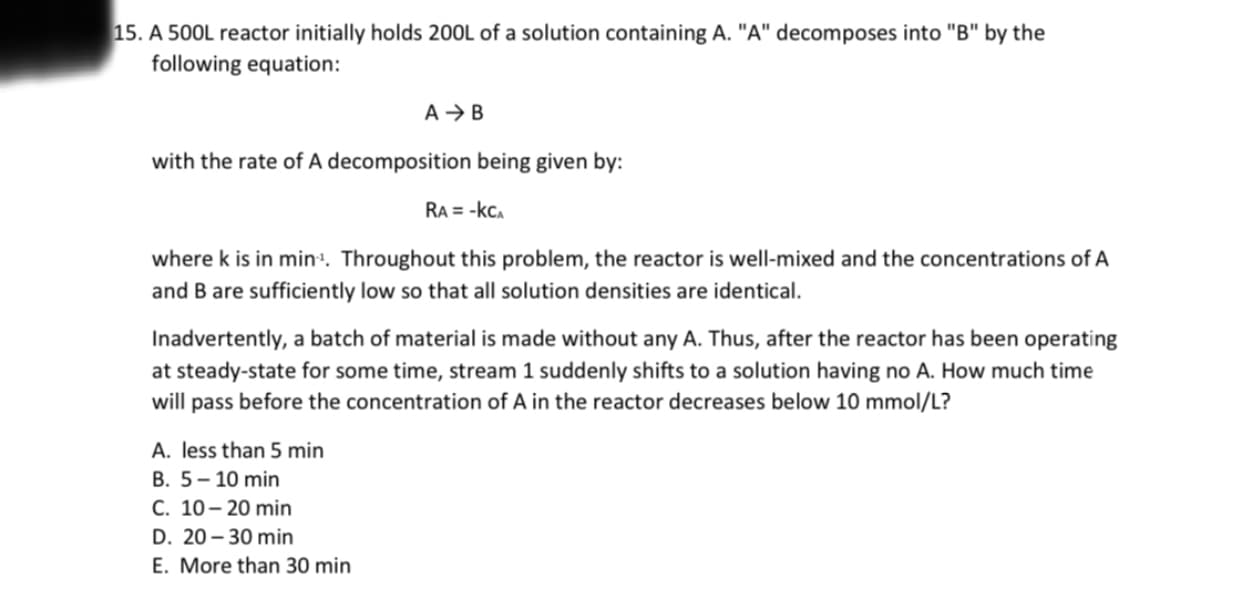15. A 500L reactor initially holds 200L of a solution containing A. "A" decomposes into "B" by the following equation: with the rate of A decomposition being given by: RA = -kc. where k is in min. Throughout this problem, the reactor is well-mixed and the concentrations of A and B are sufficiently low so that all solution densities are identical. Inadvertently, a batch of material is made without any A. Thus, after the reactor has been operating at steady-state for some time, stream 1 suddenly shifts to a solution having no A. How much time will pass before the concentration of A in the reactor decreases below 10 mmol/L? A. less than 5 min B. 5- 10 min C. 10– 20 min D. 20- 30 min E. More than 30 min
15. A 500L reactor initially holds 200L of a solution containing A. "A" decomposes into "B" by the following equation: with the rate of A decomposition being given by: RA = -kc. where k is in min. Throughout this problem, the reactor is well-mixed and the concentrations of A and B are sufficiently low so that all solution densities are identical. Inadvertently, a batch of material is made without any A. Thus, after the reactor has been operating at steady-state for some time, stream 1 suddenly shifts to a solution having no A. How much time will pass before the concentration of A in the reactor decreases below 10 mmol/L? A. less than 5 min B. 5- 10 min C. 10– 20 min D. 20- 30 min E. More than 30 min
Introduction to Chemical Engineering Thermodynamics
8th Edition
ISBN:9781259696527
Author:J.M. Smith Termodinamica en ingenieria quimica, Hendrick C Van Ness, Michael Abbott, Mark Swihart
Publisher:J.M. Smith Termodinamica en ingenieria quimica, Hendrick C Van Ness, Michael Abbott, Mark Swihart
Chapter1: Introduction
Section: Chapter Questions
Problem 1.1P
Related questions
Question

Transcribed Image Text:15. A 500L reactor initially holds 200L of a solution containing A. "A" decomposes into "B" by the
following equation:
with the rate of A decomposition being given by:
RA = -kc.
where k is in min. Throughout this problem, the reactor is well-mixed and the concentrations of A
and B are sufficiently low so that all solution densities are identical.
Inadvertently, a batch of material is made without any A. Thus, after the reactor has been operating
at steady-state for some time, stream 1 suddenly shifts to a solution having no A. How much time
will pass before the concentration of A in the reactor decreases below 10 mmol/L?
A. less than 5 min
B. 5- 10 min
C. 10– 20 min
D. 20- 30 min
E. More than 30 min
Expert Solution
This question has been solved!
Explore an expertly crafted, step-by-step solution for a thorough understanding of key concepts.
Step by step
Solved in 3 steps with 2 images

Recommended textbooks for you

Introduction to Chemical Engineering Thermodynami…
Chemical Engineering
ISBN:
9781259696527
Author:
J.M. Smith Termodinamica en ingenieria quimica, Hendrick C Van Ness, Michael Abbott, Mark Swihart
Publisher:
McGraw-Hill Education

Elementary Principles of Chemical Processes, Bind…
Chemical Engineering
ISBN:
9781118431221
Author:
Richard M. Felder, Ronald W. Rousseau, Lisa G. Bullard
Publisher:
WILEY

Elements of Chemical Reaction Engineering (5th Ed…
Chemical Engineering
ISBN:
9780133887518
Author:
H. Scott Fogler
Publisher:
Prentice Hall

Introduction to Chemical Engineering Thermodynami…
Chemical Engineering
ISBN:
9781259696527
Author:
J.M. Smith Termodinamica en ingenieria quimica, Hendrick C Van Ness, Michael Abbott, Mark Swihart
Publisher:
McGraw-Hill Education

Elementary Principles of Chemical Processes, Bind…
Chemical Engineering
ISBN:
9781118431221
Author:
Richard M. Felder, Ronald W. Rousseau, Lisa G. Bullard
Publisher:
WILEY

Elements of Chemical Reaction Engineering (5th Ed…
Chemical Engineering
ISBN:
9780133887518
Author:
H. Scott Fogler
Publisher:
Prentice Hall


Industrial Plastics: Theory and Applications
Chemical Engineering
ISBN:
9781285061238
Author:
Lokensgard, Erik
Publisher:
Delmar Cengage Learning

Unit Operations of Chemical Engineering
Chemical Engineering
ISBN:
9780072848236
Author:
Warren McCabe, Julian C. Smith, Peter Harriott
Publisher:
McGraw-Hill Companies, The